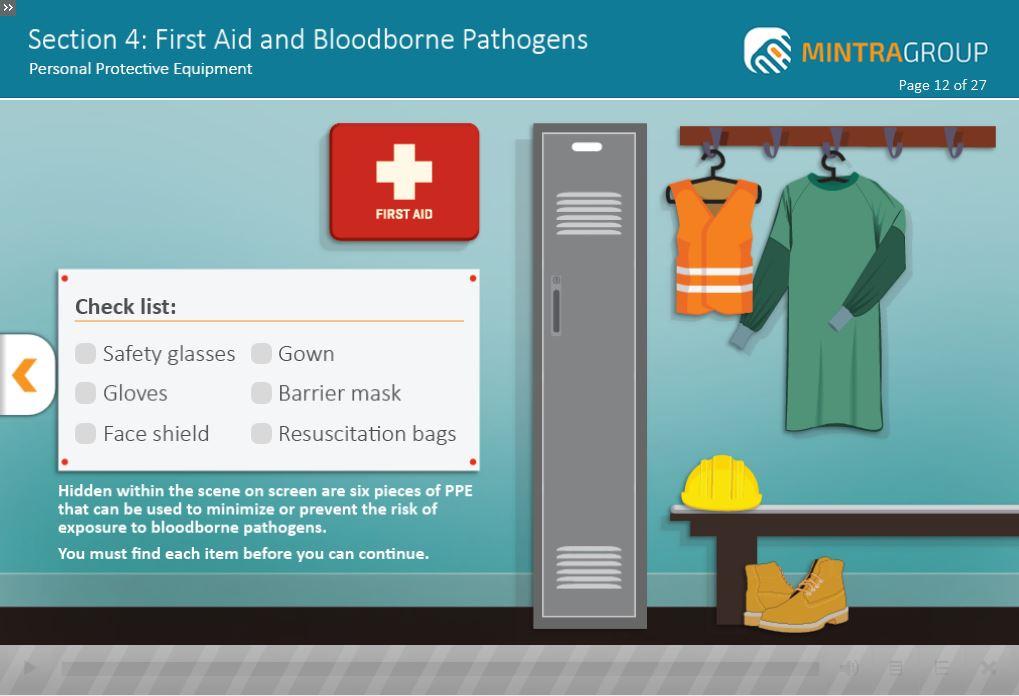Buy and assign to
multiple learners
Instant access
via email link
Instant certificate
via email
Further Information - First Aid & Bloodborne Pathogens (US) Training
Description
Who is this course for?
This First Aid & Bloodborne Pathogens (US) Training course is for personnel requiring awareness or understanding of the protection against bloodborne pathogens in a first aid situation.
Is previous experience required?
You do not need prior knowledge or experience to complete this course.
How will this course benefit me?
This course is designed to give personnel a basic overview of how to treat a casualty who is injured at work and provide an awareness of the risk of exposure to bloodborne pathogens and what to do if exposure occurs.
The course consists of following sections:
Section 1: Casualty Assessment
Section 2: Cardiopulmonary Resuscitation (CPR)
Section 3: Treating Different Types of Injuries
Section 4: Bloodborne Pathogens
How will this course benefit my company?
By ensuring you have a basic overview of how to treat a casualty who is injured at work and provide an awareness of the risk of exposure to bloodborne pathogens and what to do if exposure occurs.
What standards are referred to in this course?
This course does not refer to specific legislation or standards but is written according to industry best practice.
Is there an assessment?
Once you have completed the course, you will be asked a series of questions to check your knowledge and understanding. These are based on the learning objectives for the course and have a pass mark of 80%.
Learning Objectives
• Describe how to carry out a casualty assessment
• Describe how to put a casualty in the recovery position
• Explain how to carry out cardiopulmonary resuscitation (CPR)
• Describe how to carry out chest compressions on an adult
• Explain how to carry out rescue breaths
• Describe what to do in the event of a suspected skeletal injury
• Describe what to do in the event of a suspected spinal injury
• Explain what to do if a casualty is suffering from anaphylactic shock
• Describe the actions to take if a casualty is suffering from shock
• Identify the actions to take if a casualty is choking
• Explain how to treat a casualty with an eye injury
• Describe how to treat injuries involving poisons
• Explain how to treat burns and scalds
• Explain what to do if a casualty is suffering from a suspected heart attack
• Identify the contents of a typical first aid kit
• Explain how to treat bleeding injuries
• Define what is meant by the term bloodborne pathogens
• Identify modes of transmission for bloodborne pathogens
• Explain the purpose of an Exposure Control Plan
• Give examples of preventive control measures that can reduce or eliminate exposure
• Give an overview of the proper usage and handling of personal protective equipment
• Describe decontamination best practice for blood and other potentially infectious materials
• Describe the actions to take if an exposure incident occurs
• Identify the measures to be taken if the skin or eyes are exposed to infectious material
Assessment
Once you have completed the course, you will be asked a series of questions to check your knowledge and understanding. These are based on the learning objectives for the course and have a pass mark of 80%.
System Requirements
• Internet access - users will need a device with a web browser and internet connection
• System - runs on computers, tablets and mobile devices using Windows 7 and above and MAC OS devices running IOS 11 and above
• Browsers - Edge, Chrome, Firefox and Safari
• Minimum browser size - none
• Audio - requires device speaker or headphones
Recommended Courses
Reviews
Insights & News
At Mintra, we're so much more than just a team—we're a force driving innovation and excellence in maritime training across Europe.
We’re excited to be taking the stage at one of Europe’s leading showcases of organisational learning.
We are delighted to share the exciting news that our People and Culture team has been shortlisted for the prestigious cHeRries Awards!




